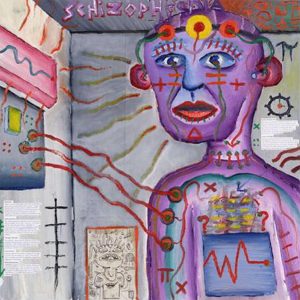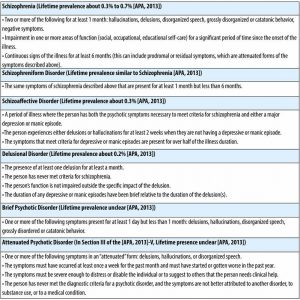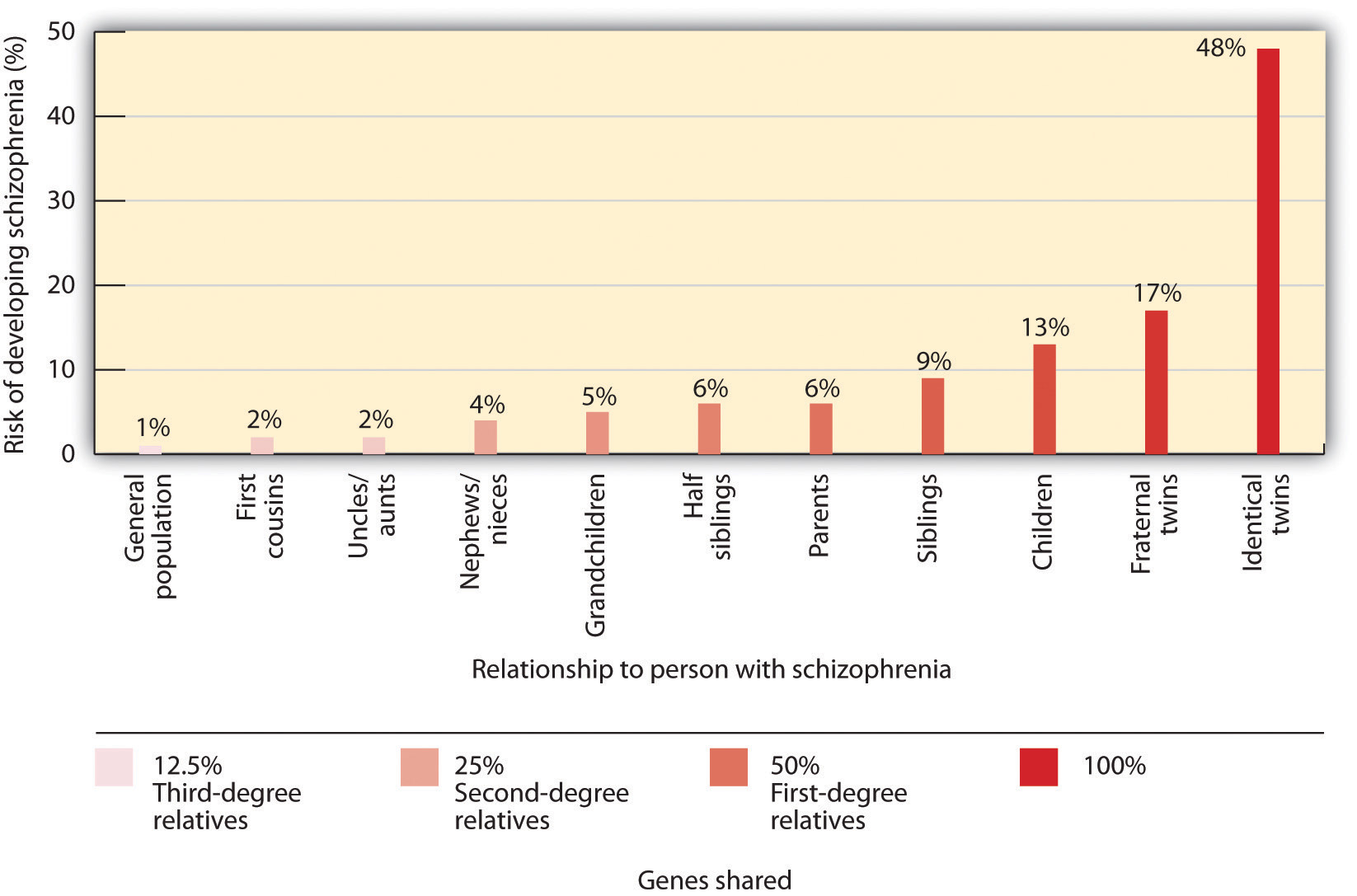15.6 Schizophrenia: The Edge of Reality
Learning Objectives
- Describe the signs and symptoms of schizophrenia and related psychotic disorders.
- Describe the most well-replicated cognitive and neurobiological changes associated with schizophrenia.
- Describe the potential risk factors for the development of schizophrenia.
Schizophrenia and the other psychotic disorders are some of the most impairing forms of psychopathology, frequently associated with a profound negative effect on the individual’s educational, occupational, and social function. Sadly, these disorders often manifest right at time of the transition from adolescence to adulthood, just as young people should be evolving into independent young adults. The spectrum of psychotic disorders includes schizophrenia, schizoaffective disorder, delusional disorder, schizotypal personality disorder, schizophreniform disorder, brief psychotic disorder, as well as psychosis associated with substance use or medical conditions. In this section, we summarize the primary clinical features of these disorders, describe the cognitive and neurobiological changes associated with schizophrenia, and describe potential risk factors and causes for the development of schizophrenia
The phenomenology of schizophrenia and related psychotic disorders
Most of you have probably had the experience of walking down the street in a city and seeing a person you thought was acting oddly. They may have been dressed in an unusual way, perhaps disheveled or wearing an unusual collection of clothes, makeup, or jewelry that did not seem to fit any particular group or subculture. They may have been talking to themselves or yelling at someone you could not see. If you tried to speak to them, they may have been difficult to follow or understand, or they may have acted paranoid or started telling a bizarre story about the people who were plotting against them. If so, chances are that you have encountered an individual with schizophrenia or another type of psychotic disorder. If you have watched the movie A Beautiful Mind (2001) or The Fisher King (1991), you have also seen a portrayal of someone thought to have schizophrenia. It is also likely that you have met people with schizophrenia without ever knowing it, as they may suffer in silence or stay isolated to protect themselves from the horrors they see, hear, or believe are operating in the outside world. As these examples begin to illustrate, psychotic disorders involve many different types of symptoms, including delusions, hallucinations, disorganized speech and behaviour, abnormal motor behaviour including catatonia, and negative symptoms such as anhedonia or amotivation and blunted affect or reduced speech.
Delusions are false beliefs that are often fixed, hard to change even when the person is presented with conflicting information, and are often culturally influenced in their content (e.g., delusions involving Jesus in Judeo-Christian cultures or delusions involving Allah in Muslim cultures). They can be terrifying for the person, who may remain convinced that they are true even when loved ones and friends present them with clear information that they cannot be true. There are many different types or themes to delusions.

The most common delusions are persecutory and involve the belief that individuals or groups are trying to hurt, harm, or plot against the person in some way. These can be people that the person knows (e.g., people at work, the neighbours, or family members), or more abstract groups (e.g., the FBI, the CIA, or aliens). Other types of delusions include grandiose delusions, where the person believes that they have some special power or ability (e.g., I am the new Buddha or I am a rock star); referential delusions, where the person believes that events or objects in the environment have special meaning for them (e.g., that song on the radio is being played specifically for me); or other types of delusions, where the person may believe that others are controlling their thoughts and actions, their thoughts are being broadcast aloud, others can read their mind, or they can read other people’s minds.
When you see a person on the street talking to themselves or shouting at other people, they are experiencing hallucinations. These are perceptual experiences that occur even when there is no stimulus in the outside world generating the experiences. They can be auditory, visual, olfactory (i.e., smell), gustatory (i.e., taste), or somatic (i.e., touch). The most common hallucinations in psychosis for adults are auditory, and they can involve one or more voices talking about the person, commenting on the person’s behaviour, or giving them orders. The content of the hallucinations is frequently negative (e.g., “you are a loser,” “that drawing is stupid,” or “you should go kill yourself”) and can be the voice of someone the person knows or a complete stranger. Sometimes the voices sound as if they are coming from outside the person’s head. Other times the voices seem to be coming from inside the person’s head but are not experienced the same as the person’s inner thoughts or inner speech.

Talking to someone with schizophrenia is sometimes difficult, as their speech may be difficult to follow, either because their answers do not clearly flow from your questions or because one sentence does not logically follow from another. This is referred to as disorganized speech, and it can be present even when the person is writing. Disorganized behaviour can include odd dress, odd makeup (e.g., lipstick partially outlining their mouth), or unusual rituals (e.g., repetitive hand gestures). Abnormal motor behaviour can include catatonia, which refers to a variety of behaviours that seem to reflect a reduction in responsiveness to the external environment. This can include holding unusual postures for long periods of time, failing to respond to verbal or motor prompts from another person, or excessive and seemingly purposeless motor activity. The symptoms of schizophrenia discussed so far are known as positive symptoms, meaning that they are experiences that we typically expect most people not to have.
Some of the most debilitating symptoms of schizophrenia are difficult for others to see. These include what people refer to as negative symptoms, or the absence of certain things we typically expect most people to have. For example, anhedonia and amotivation reflect a lack of apparent interest in or drive to engage in social or recreational activities. These symptoms can manifest as a great amount of time spent in physical immobility. Importantly, anhedonia and amotivation do not seem to reflect a lack of enjoyment in pleasurable activities or events (Cohen & Minor, 2010; Kring & Moran, 2008; Llerena, Strauss, & Cohen, 2012), but rather a reduced drive or ability to take the steps necessary to obtain the potentially positive outcomes (Barch & Dowd, 2010). Flat affect and reduced speech (i.e., alogia) reflect a lack of showing emotions through facial expressions, gestures, and speech intonation, as well as a reduced amount of speech and increased pause frequency and duration.
In many ways, the types of symptoms associated with psychosis are the most difficult for us to understand, as they may seem far outside the range of our normal experiences. Unlike depression or anxiety, many of us may not have had experiences that we think of as on the same continuum as psychosis. However, just like many of the other forms of psychopathology described in this book, the types of psychotic symptoms that characterize disorders like schizophrenia are on a continuum with “normal” mental experiences. For example, work by Jim van Os in the Netherlands has shown that a surprisingly large percentage of the general population, over 10%, experience psychotic-like symptoms, though many fewer have multiple experiences and most will not continue to experience these symptoms in the long run (Verdoux & van Os, 2002). Similarly, work in a general population of adolescents and young adults in Kenya has also shown that a relatively high percentage of individuals, roughly 19%, experience one or more psychotic-like experiences at some point in their lives (Mamah et al., 2012; Ndetei et al., 2012), though again most will not go on to develop a full-blown psychotic disorder.
Schizophrenia is the primary disorder that comes to mind when we discuss psychotic disorders (see Figure 15.18), though there are a number of other disorders that share one or more features with schizophrenia. In the remainder of this section, we will use the terms “psychosis” and “schizophrenia” somewhat interchangeably, given that most of the research has focused on schizophrenia. In addition to schizophrenia, other psychotic disorders include schizophreniform disorder, which is a briefer version of schizophrenia, schizoaffective disorder, which is a mixture of psychosis and depression or mania symptoms, delusional disorder, which is the experience of only delusions, and brief psychotic disorder, which involves psychotic symptoms that last only a few days or weeks.

The cognitive neuroscience of schizophrenia
As described above, when we think of the core symptoms of psychotic disorders such as schizophrenia, we think of people who hear voices, see visions, and have false beliefs about reality (i.e., delusions). However, problems in cognitive function are also a critical aspect of psychotic disorders and of schizophrenia in particular. This emphasis on cognition in schizophrenia is in part due to the growing body of research suggesting that cognitive problems in schizophrenia are a major source of disability and loss of functional capacity (Green, 2006; Nuechterlein et al., 2011). The cognitive deficits that are present in schizophrenia are widespread and can include problems with episodic memory — that is, the ability to learn and retrieve new information or episodes in one’s life — working memory — that is, the ability to maintain information over a short period of time, such as 30 seconds — and other tasks that require one to control or regulate one’s behaviour (Barch & Ceaser, 2012; Bora, Yucel, & Pantelis, 2009a; Fioravanti, Carlone, Vitale, Cinti, & Clare, 2005; Forbes, Carrick, McIntosh, & Lawrie, 2009; Mesholam-Gately, Giuliano, Goff, Faraone, & Seidman, 2009). Individuals with schizophrenia also have difficulty with what is referred to as processing speed and are frequently slower than healthy individuals on almost all tasks. Importantly, these cognitive deficits are present prior to the onset of the illness (Fusar-Poli et al., 2007) and are also present, albeit in a milder form, in the first-degree relatives of people with schizophrenia (Snitz, Macdonald, & Carter, 2006). This suggests that cognitive impairments in schizophrenia reflect part of the risk for the development of psychosis, rather than being an outcome of developing psychosis. Further, people with schizophrenia who have more severe cognitive problems also tend to have more severe negative symptoms and more disorganized speech and behaviour (Barch, Carter, & Cohen, 2003; Barch et al., 1999; de Garcia Dominguez, Viechtbauer, Simons, van Os, & Krabbendam, 2009; Ventura, Hellemann, Thames, Koellner, & Nuechterlein, 2009; Ventura, Thames, Wood, Guzik, & Hellemann, 2010). In addition, people with more cognitive problems have worse function in everyday life (Bowie et al., 2008; Bowie, Reichenberg, Patterson, Heaton, & Harvey, 2006; Fett et al., 2011).

Some people with schizophrenia also show deficits in what is referred to as social cognition, though it is not clear whether such problems are separate from the cognitive problems described above or the result of them (Hoe, Nakagami, Green, & Brekke, 2012; Kerr & Neale, 1993; van Hooren et al., 2008). This includes problems with the recognition of emotional expressions on the faces of other individuals (Kohler, Walker, Martin, Healey, & Moberg, 2010) and problems inferring the intentions of other people (theory of mind; Bora, Yucel, & Pantelis, 2009b). Individuals with schizophrenia who have more problems with social cognition also tend to have more negative and disorganized symptoms (Ventura, Wood, & Hellemann, 2011), as well as worse community function (Fett et al., 2011).
The advent of neuroimaging techniques — such as structural magnetic resonance imaging (MRI), functional magnetic resonance imaging (fMRI), and positron emission tomography (PET) — opened up the ability to try to understand the brain mechanisms of the symptoms of schizophrenia as well as the cognitive impairments found in psychosis. For example, a number of studies have suggested that delusions in psychosis may be associated with problems in salience detection mechanisms supported by the ventral striatum (Jensen & Kapur, 2009; Jensen et al., 2008; Kapur, 2003; Kapur, Mizrahi, & Li, 2005; Murray et al., 2008) and the anterior prefrontal cortex (Corlett et al., 2006; Corlett, Honey, & Fletcher, 2007; Corlett, Murray, et al., 2007). These are regions of the brain that normally increase their activity when something important (i.e., salient) happens in the environment. If these brain regions misfire, it may lead individuals with psychosis to mistakenly attribute importance to irrelevant or unconnected events. Further, there is good evidence that problems in working memory and cognitive control in schizophrenia are related to problems in the function of the dorsolateral prefrontal cortex (DLPFC), a region of the brain (Minzenberg, Laird, Thelen, Carter, & Glahn, 2009; Ragland et al., 2009). These problems include changes in how the DLPFC works when people are doing working-memory or cognitive-control tasks, and problems with how this brain region is connected to other brain regions important for working memory and cognitive control, including the posterior parietal cortex (e.g., Karlsgodt et al., 2008; J. J. Kim et al., 2003; Schlosser et al., 2003), the anterior cingulate (Repovs & Barch, 2012), and temporal cortex (e.g., Fletcher et al., 1995; Meyer-Lindenberg et al., 2001). In terms of understanding episodic memory problems in schizophrenia, many researchers have focused on medial temporal lobe deficits, with a specific focus on the hippocampus (e.g., Heckers & Konradi, 2010). This is because there is much data from humans and animals showing that the hippocampus is important for the creation of new memories (Squire, 1992). However, it has become increasingly clear that problems with the DLPFC also make important contributions to episodic memory deficits in schizophrenia (Ragland et al., 2009), probably because this part of the brain is important for controlling our use of memory.
In addition to problems with regions such as the DLPFC and medial temporal lobes in schizophrenia described above, magnitude resonance neuroimaging studies have also identified changes in cellular architecture, white matter connectivity, and gray matter volume in a variety of regions that include the prefrontal and temporal cortices (Bora et al., 2011). People with schizophrenia also show reduced overall brain volume; as people get older, these reductions in brain volume may be larger in those with schizophrenia than in healthy people (Olabi et al., 2011). Taking antipsychotic medications or taking drugs such as marijuana, alcohol, and tobacco may cause some of these structural changes. However, these structural changes are not completely explained by medications or substance use alone. Further, both functional and structural brain changes are seen, again to a milder degree, in the first-degree relatives of people with schizophrenia (Boos, Aleman, Cahn, Pol, & Kahn, 2007; Brans et al., 2008; Fusar-Poli et al., 2007; MacDonald, Thermenos, Barch, & Seidman, 2009). This again suggests that that neural changes associated with schizophrenia are related to a genetic risk for this illness.
Many researchers believe that schizophrenia is caused in part by excess dopamine, and this theory is supported by the fact that most of the drugs useful in treating schizophrenia inhibit dopamine activity in the brain (Javitt & Laruelle, 2006). Levels of serotonin may also play a part (Inayama et al., 1996), but recent evidence suggests that the role of neurotransmitters in schizophrenia is more complicated than was once believed. It also remains unclear whether observed differences in the neurotransmitter systems of people with schizophrenia cause the disease, or if they are the result of the disease itself or its treatment (Csernansky & Grace, 1998).
Risk factors for developing schizophrenia
It is clear that there are important genetic contributions to the likelihood that someone will develop schizophrenia, with consistent evidence from family, twin, and adoption studies. (Sullivan, Kendler, & Neale, 2003). The likelihood of developing schizophrenia increases dramatically if a close relative also has the disease (see Figure 15.20).

However, there is no schizophrenia gene, and it is likely that the genetic risk for schizophrenia reflects the summation of many different genes that each contribute something to the likelihood of developing psychosis (Gottesman & Shields, 1967; Owen, Craddock, & O’Donovan, 2010). Further, schizophrenia is a very heterogeneous disorder, which means that two different people with schizophrenia may each have very different symptoms (e.g., one has hallucinations and delusions, while the other has disorganized speech and negative symptoms). This makes it even more challenging to identify specific genes associated with risk for psychosis. Importantly, many studies also now suggest that at least some of the genes potentially associated with schizophrenia are also associated with other mental health conditions, including bipolar disorder, depression, and autism (Gejman, Sanders, & Kendler, 2011; Y. Kim, Zerwas, Trace, & Sullivan, 2011; Owen et al., 2010; Rutter, Kim-Cohen, & Maughan, 2006).

There are also a number of environmental factors that are associated with an increased risk of developing schizophrenia. For example, problems during pregnancy such as increased stress, infection, malnutrition, and diabetes have been associated with increased risk of schizophrenia. In addition, complications that occur at the time of birth and which cause hypoxia (i.e., lack of oxygen) are also associated with an increased risk for developing schizophrenia (M. Cannon, Jones, & Murray, 2002; Miller et al., 2011). Children born to older fathers are also at a somewhat increased risk of developing schizophrenia. Further, using cannabis increases risk for developing psychosis, especially if you have other risk factors (Casadio, Fernandes, Murray, & Di Forti, 2011; Luzi, Morrison, Powell, di Forti, & Murray, 2008). The likelihood of developing schizophrenia is also higher for kids who grow up in urban settings (March et al., 2008) and for some minority ethnic groups (Bourque, van der Ven, & Malla, 2011). Both of these factors may reflect higher social and environmental stress in these settings. Unfortunately, none of these risk factors is specific enough to be particularly useful in a clinical setting, and most people with these risk factors do not develop schizophrenia. However, together they are beginning to give us clues as the neurodevelopmental factors that may lead someone to be at an increased risk for developing this disease.
An important research area on risk for psychosis has been work with individuals who may be at “clinical high risk.” These are individuals who are showing attenuated (i.e., milder) symptoms of psychosis that have developed recently and who are experiencing some distress or disability associated with these symptoms. When people with these types of symptoms are followed over time, about 35% of them develop a psychotic disorder (T. D. Cannon et al., 2008), most frequently schizophrenia (Fusar-Poli, McGuire, & Borgwardt, 2012). In order to identify these individuals, a new category of diagnosis, called “attenuated psychotic syndrome,” was added to Section III, the section for disorders in need of further study, of the DSM-5 (American Psychiatric Association, 2013); for symptoms, see Figure 15.18. However, adding this diagnostic category to the DSM-5 created a good deal of controversy (Batstra & Frances, 2012; Fusar-Poli & Yung, 2012). Many scientists and clinicians have been worried that including risk states in the DSM-5 would create mental disorders where none exist, that these individuals are often already seeking treatment for other problems, and that it is not clear that we have good treatments to stop these individuals from developing to psychosis. However, the counterarguments have been that there is evidence that individuals with high-risk symptoms develop psychosis at a much higher rate than individuals with other types of psychiatric symptoms and that the inclusion of attenuated psychotic syndrome in Section III will spur important research that might have clinical benefits. Further, there is some evidence that non-invasive treatments, such as omega-3 fatty acids and intensive family intervention, may help reduce the development of full-blown psychosis (Preti & Cella, 2010) in people who have high-risk symptoms.
Source: Adapted from Barch (2020).
Key Takeaways
- Schizophrenia is a serious psychological disorder marked by delusions, hallucinations, and loss of contact with reality.
- Schizophrenia is accompanied by a variety of symptoms, but not all patients have all of them.
- Because the schizophrenic patient has lost contact with reality, we say that they are experiencing psychosis.
- Positive symptoms of schizophrenia include hallucinations, delusions, derailment, disorganized behaviour, inappropriate affect, and catatonia.
- Negative symptoms of schizophrenia include social withdrawal, poor hygiene and grooming, poor problem-solving abilities, and a distorted sense of time.
- Cognitive symptoms of schizophrenia include difficulty comprehending and using information and problems maintaining focus.
- There is no single cause of schizophrenia. Rather, there are a variety of biological and environmental risk factors that interact in a complex way to increase the likelihood that someone might develop schizophrenia.
Exercises and Critical Thinking
- What are the major differences between the psychotic disorders discussed in this section?
- How would one be able to tell when an individual is delusional versus having non-delusional beliefs that differ from the societal normal? How should cultural and sub-cultural variations be taken into account when assessing psychotic symptoms?
- Why are cognitive impairments important to understanding schizophrenia?
- Why has the inclusion of attenuated psychotic syndrome in Section III of the DSM-5 created controversy?
- What are some of the factors associated with increased risk for developing schizophrenia? If we know whether or not someone has these risk factors, how well can we tell whether they will develop schizophrenia?
Image Attributions
Figure 15.16. W Beauty by Thomas Hawk is used under a CC BY-NC 2.0 license.
Figure 15.17. Artistic View of How the World Feels Like With Schizophrenia – Journal.pmed.0020146.g001 by Craig Finn has been dedicated to the public domain (CC0 1.0).
Figure 15.18. Used under a CC BY-NC-SA 4.0 license.
Figure 15.19. Schizophrenia on Vimeo by Ralph Buckley by Ralph Buckley is used under a CC BY-SA 2.0 license.
Figure 15.20. Used under a CC BY-NC-SA 4.0 license.
Figure 15.21. Used under a CC BY-NC-SA 4.0 license.
Long Descriptions
Figure 15.20. Genetic disposition to develop schizophrenia:
| Genes shared | Relationship to person with schizophrenia | Risk of developing schizophrenia (%) |
|---|---|---|
| Third-degree relatives (12.5%) | First cousins | 2% |
| Uncles and aunts | 2% | |
| Second-degree relatives (25%) | Nephews and nieces | 4% |
| Grandchildren | 5% | |
| First-degree relatives (50%) | Half-siblings | 6% |
| Parents | 6% | |
| 100% | Siblings | 9% |
| Children | 13% | |
| Fraternal twins | 17% | |
| Identical twins | 48% |
References
American Psychiatric Association. (2013). Diagnostic and statistical manual of mental disorders (5th ed.). Washington, DC: Author.
Barch, D. M. (2020). Schizophrenia spectrum disorders. In R. Biswas-Diener & E. Diener (Eds.), Noba textbook series: Psychology. Champaign, IL: DEF. Retrieved from http://noba.to/5d98nsy4
Barch, D. M., & Ceaser, A. E. (2012). Cognition in schizophrenia: Core psychological and neural mechanisms. Trends in Cognitive Science, 16, 27–34.
Barch, D. M., Carter, C. S., & Cohen, J. D. (2003). Context processing deficit in schizophrenia: Diagnostic specificity, 4-week course, and relationships to clinical symptoms. Journal of Abnormal Psychology, 112, 132–143.
Barch, D. M., Carter, C. S., Macdonald, A., Sabb, F. W., Noll, D. C., & Cohen, J. D. (1999). Prefrontal cortex and context processing in medication-naive first-episode patients with schizophrenia. Schizophrenia Research, 36(1–3), 217–218.
Barch, D. M., & Dowd, E. C. (2010). Goal representations and motivational drive in schizophrenia: The role of prefrontal-striatal interactions. Schizophrenia Bulletin, 36(5), 919–934.
Batstra, L., & Frances, A. (2012). Diagnostic inflation: Causes and a suggested cure. The Journal of Nervous and Mental Disease, 200(6), 474–479.
Boos, H. B., Aleman, A., Cahn, W., Pol, H. H., & Kahn, R. S. (2007). Brain volumes in relatives of patients with schizophrenia: A meta-analysis. Archives of General Psychiatry, 64(3), 297–304.
Bora, E., Fornito, A., Radua, J., Walterfang, M., Seal, M., Wood, S. J., . . . Pantelis, C. (2011). Neuroanatomical abnormalities in schizophrenia: A multimodal voxelwise meta-analysis and meta-regression analysis. Schizophrenia Research, 127(1–3), 46–57.
Bora, E., Yucel, M., & Pantelis, C. (2009a). Cognitive functioning in schizophrenia, schizoaffective disorder and affective psychoses: Meta-analytic study. The British Journal of Psychiatry, 195(6), 475–482.
Bora, E., Yucel, M., & Pantelis, C. (2009b). Theory of mind impairment in schizophrenia: Meta-analysis. Schizophrenia Research, 109(1–3), 1–9.
Bourque, F., van der Ven, E., & Malla, A. (2011). A meta-analysis of the risk for psychotic disorders among first- and second-generation immigrants. Psychological Medicine, 41(5), 897–910.
Bowie, C. R., Leung, W. W., Reichenberg, A., McClure, M. M., Patterson, T. L., Heaton, R. K., & Harvey, P. D. (2008). Predicting schizophrenia patients’ real-world behavior with specific neuropsychological and functional capacity measures. Biological Psychiatry, 63(5), 505–511.
Bowie, C. R., Reichenberg, A., Patterson, T. L., Heaton, R. K., & Harvey, P. D. (2006). Determinants of real-world functional performance in schizophrenia subjects: Correlations with cognition, functional capacity, and symptoms. The American Journal of Psychiatry, 163(3), 418–425.
Brans, R. G., van Haren, N. E., van Baal, G. C., Schnack, H. G., Kahn, R. S., & Hulshoff Pol, H. E. (2008). Heritability of changes in brain volume over time in twin pairs discordant for schizophrenia. Archives of General Psychiatry, 65(11), 1259–1268.
Cannon, M., Jones, P. B., & Murray, R. M. (2002). Obstetric complications and schizophrenia: Historical and meta-analytic review. The American Journal of Psychiatry, 159(7), 1080–1092.
Cannon, T. D., Cadenhead, K., Cornblatt, B., Woods, S. W., Addington, J., Walker, E., . . . Heinssen, R. (2008). Prediction of psychosis in youth at high clinical risk: A multisite longitudinal study in North America. Archives of General Psychiatry, 65(1), 28–37.
Casadio, P., Fernandes, C., Murray, R. M., & Di Forti, M. (2011). Cannabis use in young people: The risk for schizophrenia. Neuroscience & Biobehavioral Reviews, 35(8), 1779–1787.
Cohen, A. S., & Minor, K. S. (2010). Emotional experience in patients with schizophrenia revisited: Meta-analysis of laboratory studies. Schizophrenia Bulletin, 36(1), 143–150.
Corlett, P. R., Honey, G. D., Aitken, M. R., Dickinson, A., Shanks, D. R., Absalom, A. R., . . . Fletcher, P. C. (2006). Frontal responses during learning predict vulnerability to the psychotogenic effects of ketamine: Linking cognition, brain activity, and psychosis. Archives of General Psychiatry, 63(6), 611–621.
Corlett, P. R., Honey, G. D., & Fletcher, P. C. (2007). From prediction error to psychosis: Ketamine as a pharmacological model of delusions. Journal of Psychopharmacology, 21(3), 238–252.
Corlett, P. R., Murray, G. K., Honey, G. D., Aitken, M. R., Shanks, D. R., Robbins, T. W., . . . Fletcher, P. C. (2007). Disrupted prediction-error signal in psychosis: Evidence for an associative account of delusions. Brain: A Journal of Neurology, 130(Pt 9), 2387–2400.
Csernansky, J. G., & Grace, A. A. (1998). New models of the pathophysiology of schizophrenia: Editors’ introduction. Schizophrenia Bulletin, 24(2), 185–187.
de Gracia Dominguez, M., Viechtbauer, W., Simons, C. J., van Os, J., & Krabbendam, L. (2009). Are psychotic psychopathology and neurocognition orthogonal? A systematic review of their associations. Psychological Bulletin, 135(1), 157–171.
Fett, A. K., Viechtbauer, W., Dominguez, M. D., Penn, D. L., van Os, J., & Krabbendam, L. (2011). The relationship between neurocognition and social cognition with functional outcomes in schizophrenia: A meta-analysis. Neuroscience and Biobehavioral Reviews, 35(3), 573–588.
Fioravanti, M., Carlone, O., Vitale, B., Cinti, M. E., & Clare, L. (2005). A meta-analysis of cognitive deficits in adults with a diagnosis of schizophrenia. Neuropsychology Review, 15(2), 73–95.
Fletcher, P. C., Frith, C. D., Grasby, P. M., Shallice, T., Frackowiak, R. S. J., & Dolan, R. J. (1995). Brain systems for encoding and retrieval of auditory-verbal memory: An in vivo study in humans. Brain, 118, 401–416.
Forbes, N. F., Carrick, L. A., McIntosh, A. M., & Lawrie, S. M. (2009). Working memory in schizophrenia: A meta-analysis. Psychological Medicine, 39(6), 889–905.
Fusar-Poli, P., McGuire, P., & Borgwardt, S. (2012). Mapping prodromal psychosis: A critical review of neuroimaging studies. European Psychiatry: The Journal of the Association of European Psychiatrists, 27(3), 181–191.
Fusar-Poli, P., Perez, J., Broome, M., Borgwardt, S., Placentino, A., Caverzasi, E., . . . McGuire, P. (2007). Neurofunctional correlates of vulnerability to psychosis: A systematic review and meta-analysis. Neuroscience and Biobehavioral Reviews, 31(4), 465–484.
Fusar-Poli, P., & Yung, A. R. (2012). Should attenuated psychosis syndrome be included in DSM-5? Lancet, 379(9816), 591–592.
Gejman, P. V., Sanders, A. R., & Kendler, K. S. (2011). Genetics of schizophrenia: New findings and challenges. Annual Review of Genomics and Human Genetics, 12, 121–144.
Gottesman, I. I., & Shields, J. (1967). A polygenic theory of schizophrenia. Proceedings of the National Academy of Sciences of the United States of America, 58(1), 199–205.
Green, M. F. (2006). Cognitive impairment and functional outcome in schizophrenia and bipolar disorder. The Journal of Clinical Psychiatry, 67(10), e12.
Heckers, S., & Konradi, C. (2010). Hippocampal pathology in schizophrenia. Current Topics in Behavioral Neurosciences, 4, 529–553.
Hoe, M., Nakagami, E., Green, M. F., & Brekke, J. S. (2012). The causal relationships between neurocognition, social cognition, and functional outcome over time in schizophrenia: A latent difference score approach. Psychological Medicine, 42, 2287–2299.
Inayama, Y., Yoneda, H., Sakai, T., Ishida, T., Nonomura, Y., Kono, Y., . . . Asaba, H. (1996). Positive association between a DNA sequence variant in the serotonin 2A receptor gene and schizophrenia. American Journal of Medical Genetics, 67(1), 103–105.
Javitt, D. C., & Laruelle, M. (2006). Neurochemical theories. In J. A. Lieberman, T. S. Stroup, & D. O. Perkins (Eds.), Textbook of schizophrenia (pp. 85–116). Washington, DC: American Psychiatric Publishing.
Jensen, J., & Kapur, S. (2009). Salience and psychosis: Moving from theory to practise. Psychological Medicine, 39(2), 197–198.
Jensen, J., Willeit, M., Zipursky, R. B., Savina, I., Smith, A. J., Menon, M., . . . Kapur, S. (2008). The formation of abnormal associations in schizophrenia: Neural and behavioral evidence. Neuropsychopharmacology, 33(3), 473–479.
Kapur, S. (2003). Psychosis as a state of aberrant salience: A framework linking biology, phenomenology, and pharmacology in schizophrenia. American Journal of Psychiatry, 160(1), 13–23.
Kapur, S., Mizrahi, R., & Li, M. (2005). From dopamine to salience to psychosis—Linking biology, pharmacology and phenomenology of psychosis. Schizophrenia Research, 79(1), 59–68.
Karlsgodt, K. H., van Erp, T. G., Poldrack, R. A., Bearden, C. E., Nuechterlein, K. H., & Cannon, T. D. (2008). Diffusion tensor imaging of the superior longitudinal fasciculus and working memory in recent-onset schizophrenia. Biological Psychiatry, 63(5), 512–518.
Kerr, S. L., & Neale, J. M. (1993). Emotion perception in schizophrenia: Specific deficit or further evidence of generalized poor performance? Journal of Abnormal Psychology, 102(2), 312–318.
Kim, J. J., Kwon, J. S., Park, H. J., Youn, T., Kang, D. H., Kim, M. S., . . . Lee, M. C. (2003). Functional disconnection between the prefrontal and parietal cortices during working memory processing in schizophrenia: A [15O]H20 PET study. American Journal of Psychiatry, 160, 919–923.
Kim, Y., Zerwas, S., Trace, S. E., & Sullivan, P. F. (2011). Schizophrenia genetics: Where next? Schizophrenia Bulletin, 37(3), 456–463.
Kohler, C. G., Walker, J. B., Martin, E. A., Healey, K. M., & Moberg, P. J. (2010). Facial emotion perception in schizophrenia: A meta-analytic review. Schizophrenia Bulletin, 36(5), 1009–1019.
Kring, A. M., & Moran, E. K. (2008). Emotional response deficits in schizophrenia: Insights from affective science. Schizophrenia Bulletin, 34(5), 819–834.
Llerena, K., Strauss, G. P., & Cohen, A. S. (2012). Looking at the other side of the coin: A meta-analysis of self-reported emotional arousal in people with schizophrenia. Schizophrenia Research, 142(1–3), 65–70.
Luzi, S., Morrison, P. D., Powell, J., di Forti, M., & Murray, R. M. (2008). What is the mechanism whereby cannabis use increases risk of psychosis? Neurotoxicity Research, 14(2–3), 105–112.
MacDonald, A. W., III, Thermenos, H. W., Barch, D. M., & Seidman, L. J. (2009). Imaging genetic liability to schizophrenia: Systematic review of FMRI studies of patients’ nonpsychotic relatives. Schizophrenia Bulletin, 35(6), 1142–1162.
Mamah, D., Mbwayo, A., Mutiso, V., Barch, D. M., Constantino, J. N., Nsofor, T., . . . Ndetei, D. M. (2012). A survey of psychosis risk symptoms in Kenya. Comprehensive Psychiatry, 53(5), 516–524.
March, D., Hatch, S. L., Morgan, C., Kirkbride, J. B., Bresnahan, M., Fearon, P., & Susser, E. (2008). Psychosis and place. Epidemiologic Reviews, 30, 84–100.
Mesholam-Gately, R. I., Giuliano, A. J., Goff, K. P., Faraone, S. V., & Seidman, L. J. (2009). Neurocognition in first-episode schizophrenia: A meta-analytic review. Neuropsychology, 23(3), 315–336.
Meyer-Lindenberg, A., Poline, J., Kohn, P. D., Holt, J. L., Egan, M. F., Weinberger, D. R., & Berman, K. F. (2001). Evidence for abnormal cortical functional connectivity during working memory in schizophrenia. American Journal of Psychiatry, 158, 1809–1817.
Miller, B., Messias, E., Miettunen, J., Alaraisanen, A., Jarvelin, M. R., Koponen, H., . . . Kirkpatrick, B. (2011). Meta-analysis of paternal age and schizophrenia risk in male versus female offspring. Schizophrenia Bulletin, 37(5), 1039–1047.
Minzenberg, M. J., Laird, A. R., Thelen, S., Carter, C. S., & Glahn, D. C. (2009). Meta-analysis of 41 functional neuroimaging studies of executive function in schizophrenia. Archives of General Psychiatry, 66(8), 811–822.
Murray, G. K., Corlett, P. R., Clark, L., Pessiglione, M., Blackwell, A. D., Honey, G., . . . Fletcher, P. C. (2008). Substantia nigra/ventral tegmental reward prediction error disruption in psychosis. Molecular Psychiatry, 13(3), 267–276.
Ndetei, D. M., Muriungi, S. K., Owoso, A., Mutiso, V. N., Mbwayo, A. W., Khasakhala, L. I., . . . Mamah, D. (2012). Prevalence and characteristics of psychotic-like experiences in Kenyan youth. Psychiatry Research, 196(2–3), 235–242.
Nuechterlein, K. H., Subotnik, K. L., Green, M. F., Ventura, J., Asarnow, R. F., Gitlin, M. J., . . . Mintz, J. (2011). Neurocognitive predictors of work outcome in recent-onset schizophrenia. Schizophrenia Bulletin, 37(Suppl 2), S33–40.
Olabi, B., Ellison-Wright, I., McIntosh, A. M., Wood, S. J., Bullmore, E., & Lawrie, S. M. (2011). Are there progressive brain changes in schizophrenia? A meta-analysis of structural magnetic resonance imaging studies. Biological Psychiatry, 70(1), 88–96.
Owen, M. J., Craddock, N., & O’Donovan, M. C. (2010). Suggestion of roles for both common and rare risk variants in genome-wide studies of schizophrenia. Archives of General Psychiatry, 67(7), 667–673.
Preti, A., & Cella, M. (2010). Randomized-controlled trials in people at ultra high risk of psychosis: A review of treatment effectiveness. Schizophrenia Research, 123(1), 30–36.
Ragland, J. D., Laird, A. R., Ranganath, C., Blumenfeld, R. S., Gonzales, S. M., & Glahn, D. C. (2009). Prefrontal activation deficits during episodic memory in schizophrenia. American Journal of Psychiatry, 166(8), 863–874.
Repovs, G., & Barch, D. M. (2012). Working memory related brain network connectivity in individuals with schizophrenia and their siblings. Frontiers in Human Neuroscience, 6, 137.
Rutter, M., Kim-Cohen, J., & Maughan, B. (2006). Continuities and discontinuities in psychopathology between childhood and adult life. Journal of Child Psychology and Psychiatry, and Allied Disciplines, 47(3–4), 276–295.
Schlosser, R., Gesierich, T., Kaufmann, B., Vucurevic, G., Hunsche, S., Gawehn, J., & Stoeter, P. (2003). Altered effective connectivity during working memory performance in schizophrenia: A study with fMRI and structural equation modeling. Neuroimage, 19(3), 751–763.
Snitz, B. E., Macdonald, A. W., III, & Carter, C. S. (2006). Cognitive deficits in unaffected first-degree relatives of schizophrenia patients: A meta-analytic review of putative endophenotypes. Schizophrenia Bulletin, 32(1), 179–194.
Squire, L. R. (1992). Memory and the hippocampus: A synthesis from findings with rats, monkeys, and humans. Psychological Review, 99, 195–231.
Sullivan, P. F., Kendler, K. S., & Neale, M. C. (2003). Schizophrenia as a complex trait: Evidence from a meta-analysis of twin studies. Archives of General Psychiatry, 60(12), 1187–1192.
van Hooren, S., Versmissen, D., Janssen, I., Myin-Germeys, I., à Campo, J., Mengelers, R., . . . Krabbendam, L. (2008). Social cognition and neurocognition as independent domains in psychosis. Schizophrenia Research, 103(1–3), 257–265.
Ventura, J., Hellemann, G. S., Thames, A. D., Koellner, V., & Nuechterlein, K. H. (2009). Symptoms as mediators of the relationship between neurocognition and functional outcome in schizophrenia: A meta-analysis. Schizophrenia Research, 113(2–3), 189–199.
Ventura, J., Thames, A. D., Wood, R. C., Guzik, L. H., & Hellemann, G. S. (2010). Disorganization and reality distortion in schizophrenia: A meta-analysis of the relationship between positive symptoms and neurocognitive deficits. Schizophrenia Research, 121(1–3), 1–14.
Ventura, J., Wood, R. C., & Hellemann, G. S. (2011). Symptom domains and neurocognitive functioning can help differentiate social cognitive processes in schizophrenia: A meta-analysis. Schizophrenia Bulletin, 39(1), 102–111.
Verdoux, H., & van Os, J. (2002). Psychotic symptoms in non-clinical populations and the continuum of psychosis. Schizophrenia Research, 54(1–2), 59–65.

